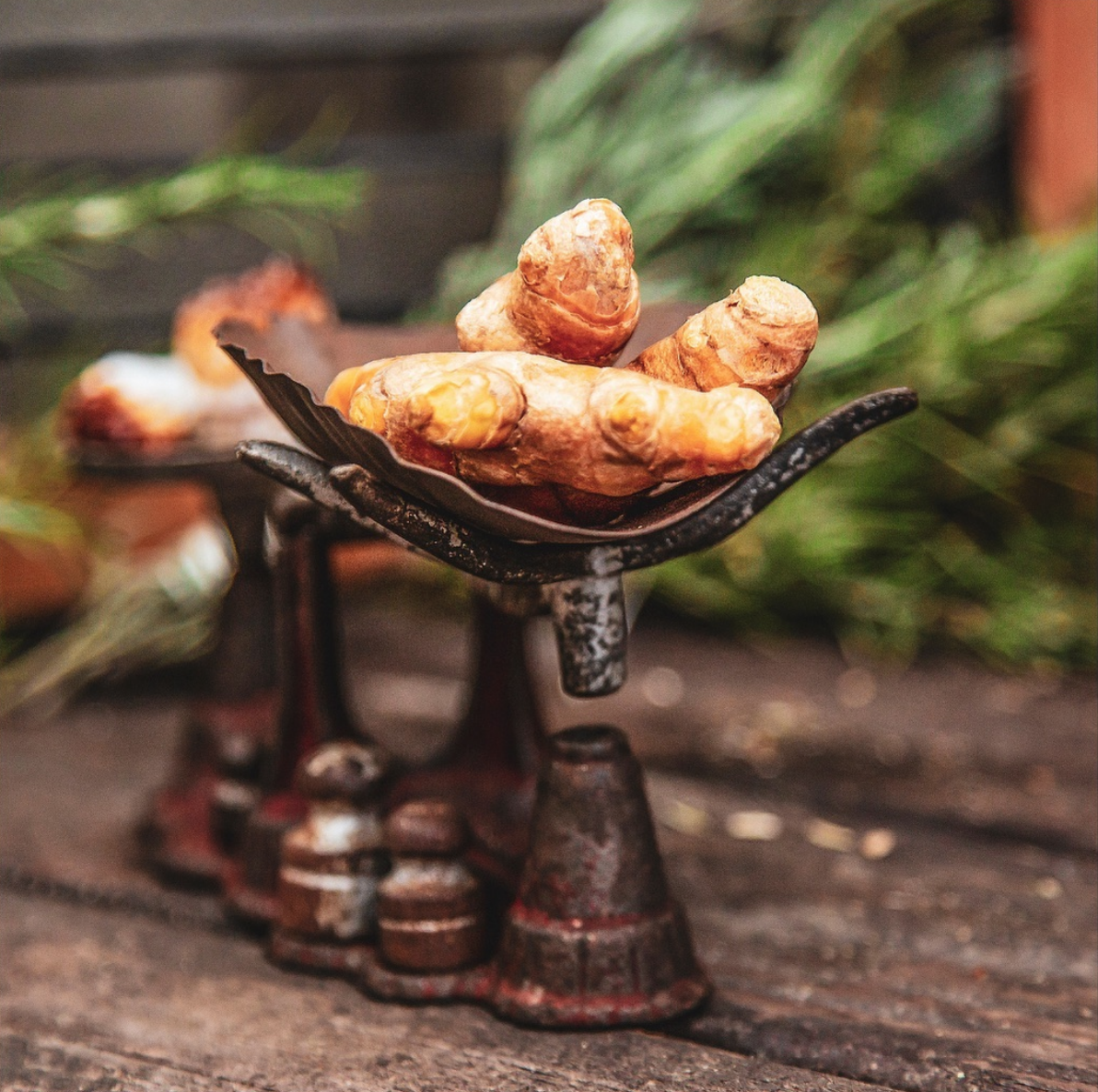Turmeric: Root of Gold
By Sarah Russo
Tap into the wisdom of an herb with a 6,000 year track record as a healing remedy, culinary spice, and dye. Turmeric (Curcuma longa), a foundational component in curry blends, is a relative of ginger that grows underground as a rhizome. Touted as the “Holy Powder of India”, turmeric is a staple in Ayurvedic practice, which uses the plant for common colds, indigestion, metabolic dysfunction, and many other ailments. The plant has also been used topically to treat wounds, acne, scabies, eczema, and inflammation.
Curcumin is the active component of turmeric that gives the spice its bright yellow hue. Curcumin is one of more than 5,000 flavonoids, a group of medicinal compounds that grant botanicals their color and flavor. There have been over 12,000 peer-reviewed studies on curcumin and turmeric, documenting numerous medicinal benefits. In western ideology, turmeric has been studied for its anti-inflammatory, antioxidant, immune boosting, and cancer preventive properties. There is more evidence-based scientific literature supporting the use of curcumin against cancer than Vitamin D or any other nutrient. Despite this, it has not been recognized as a medicine by the Food and Drug Administration.
Turmeric’s powerhouse medicinal applications may be in part due to its interaction with the endocannabinoid system. Research has identified that curcurmin’s antidepressant effects are mediated by the CB1 receptor. Additionally, the compound was found to reduce liver fibrosis by modulating the transmission of cannabinoid receptors in another study. Further investigation is warranted to examine the interaction of the plant’s compounds on the endocannabinoid system and how that influences its healing potential.
Turmeric’s well documented reputation as an anti-inflammatory is of special note, as many of the major diseases plaguing the Western population are linked to systemic inflammation. Most generic anti-inflammatories work by suppressing COX enzymes, which are responsible for blood clotting and protecting the lining of the stomach. Many pharmaceutical medicines block these receptors non-selectively, which can lead to other side effects. According to James Duke, turmeric has been found to be a natural, safer, and less expensive COX inhibitor than pharmaceutical drugs.
Curcumin has shown an ability to intensify the expression of the p53 protein, a molecule that guards the human genome. P53 is able to activate proteins that repair DNA, which can decrease the risk of undesirable mutations and tumor growth. Additionally, a turmeric extract has demonstrated the ability to protect human white blood cells from damage. The plant has been used to boost digestive vigor by increasing the secretion of bile, pancreatic, and gastric juices. This in turn may benefit those who suffer from ulcers, heartburn, and other digestive troubles.
The plant has also been used as preventative medicine. Turmeric contains potent antioxidant compounds that have neuroprotective properties throughout numerous molecular channels. It can guard against alcohol-induced brain damage and clear away a buildup of brain plaque which can lead to dementia. The plant has also been shown to improve insulin sensitivity and boost cardiovascular function.
Conditions the herb has been used for: arthritis, cancer prevention, colds, diabetes, cardiovascular diseases, joint pain, digestive issues, allergies, sports injury recovery, inflammation and related conditions, metabolic dysfunction, eczema, depression, acne, scabies, immune system support, neuroprotection, heart health, fungal infections.
Usage instructions: Curcumin is lipid-soluble, so it’s important to combine it with fats to promote bioavailability and absorption. Piperine (a compound found in black pepper) can increase the uptake of curcumin by 20 times. Use turmeric as a spice, make golden milk (recipe below), or take it in capsule or tincture form.
By Sarah Russo. Cannot be reprinted without the permission of the author.
Originally appeared on the Emerald Pharms blog.
Sources:
American Botanical Council. (2000). Excerpt from Herbal Medicine: Expanded Commission E Monographs on Turmeric.
Brugnatelli, Solange. (2016, October 31). DNA-repairing pumpkin curry.
Cording, Jessica. (2019, February 10) How To Make The Best Turmeric Tea To Fight Inflammation All Day Long
Goldstein, Bonni. (2018, August 15). Trade-In Your Ibuprofen for Cannabis.
Lee, Martin A. (2016, August 31). I’m Just Mad About Saffron.
Scholey, Andrew & Cox, Katherine (2016, October 4). Mellow yellow? The mood and cognitive effects of curcumin from turmeric.


